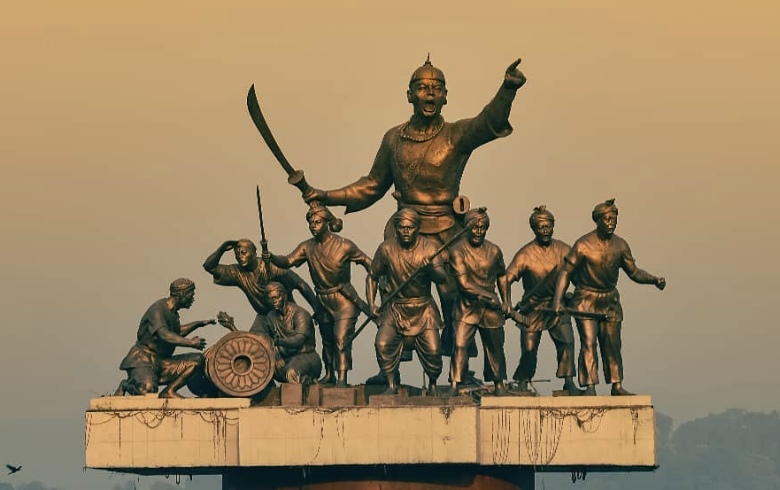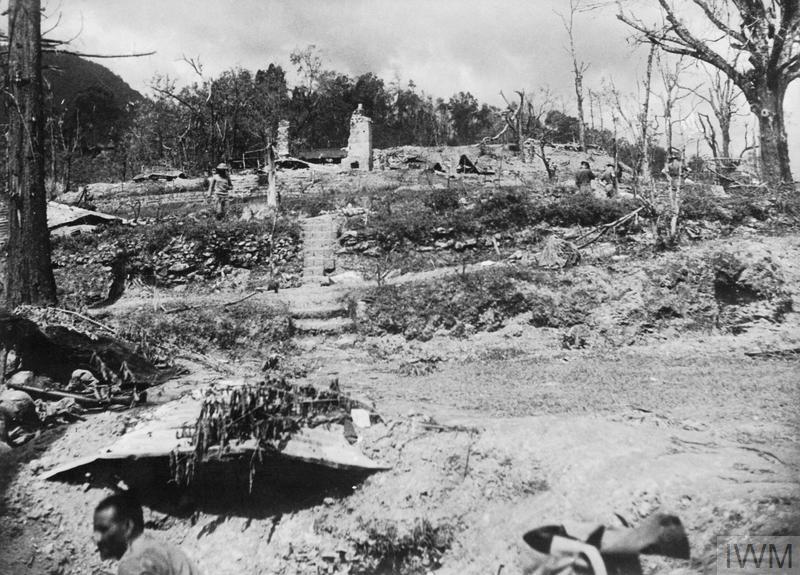NER / HISTORY & CULTURE

The statue of Lachit Borphukan on the river of Brahmaputra commemorates his heroic victory against the Mughal empire during the 1671 naval Battle of Saraighat.
PHOTOGRAPH: © Manash / @manash_hb_photography
Great armed conflicts and battles have taken place in the North East Region (NER) that remain continue to remain forgotten, even though they decisively changed the course of history at important points in time from the Indian freedom struggle to the World Wars. This neglect of regional histories is also reflected in the Indian history textbooks that students have encountered growing up. ‘I would say the NE Region featured close to nil in my BA history syllabus’, says Angarika Gogoi, a history graduate from Hindu College, University of Delhi. ‘There was a vague mention of the Battle of Saraighat and the Ahom Kingdom but only in the context of Mughal History’. Here, we dive into a few battles, armed conflicts and rebellions that have taken place in the region and their sites of importance.

The mined tennis court and terraces of the District Commissioner’s bungalow in Kohima, July 1944.
PHOTOGRAPH: © Imperial War Museums
The Battles of Kohima and Imphal remained pretty much forgotten until the National Army Museum in central London, UK declared it as ‘Britain’s Greatest Battle’. But those you remember, remember well. Filmmakers from the region such as Utpal Borpujari have focused on these battles and produced the documentary film “Memories of a Forgotten War” in a three-year long journey collecting exclusive interviews and footages of the soldiers and local people of the North east in over 20 local languages & dialects and covering remote battle locations in Manipur and Nagaland.
There are a number of sites one can visit to understand these battles from the local context. The battles took place throughout these areas in villages and remote high-altitude locations such as Point 5846 or Laimaton Peak. The trek to Laimaton Peak takes the battle route of the Japanese soldiers in 1944 to approach the Silchar-Bishenpur Track.
Museums such as World War II Museum at the Kisama Heritage Village hold and exhibits artifacts and old historic photographs related to the battles fought in Kohima and nearby areas.
There are also a number of cemeteries commemorating the soldiers lost in the wars. The Kohima War Cemetary is also the battlefield upon which countless lives of Allied Forces soldiers were lost during their resistance against the Japanese Army entering from Mizoram. The victory caused the Japanese Army to retreat back and was a turning point that changed the course of WWI history in the Campaign of the Far East. Today, it holds over 1400 burials and a memorial for the Hindu and Sikh Soldiers.
Imphal War Cemetery , located in Deulahland, Imphal town holds around 16,000 Commonwealth burials of soldiers from India, the United Kingdom and Canada who had fought the Japanese Army during the Seige of Imphal. The Cemetery is open for visit between 9AM to 4PM daily.
For those who wish to delve deeper into the war histories, local history experts also hold tours with local guides who have in-depth knowledge of the war histories and their local context. For instance, The Battlefield of Imphal Tours (BOIT) is led and organized by tour guide/leader Mr. Yaiphaba Meetei Kangjam and founded by Hemant Singh Latoch who has extensively researched and written about these battlefields.
The period from the end of the nineteenth century marked British forces’ continuous efforts in expansion into then-NEFA (North East Frontier Agency) territories in the north-east of India. The Anglo-Adi wars were fought in a series of four different conflicts between the British Indian Empire and the ‘Abhors’ – hillsmen – at Kekar Monying after the murder of Noel Williamson, a British political officer by Matmur Jamoh from the region. In the first two wars in 1858 and 1859, known as Bitbor Mimak and Bongal Mimak respectively, the Adi peoples pushed the British military expeditions back successfully. The third war of 1894 (Nijom Mimak) took place in Damroh Village and other surrounding locations where the British forces were defeated again in February. The final war of 1911 (Poju Mimak) ended with the fall of the Kekar Monying blockade and a British victory. Both sides suffered serious casualties, especially in the last war among the Adi communities who put up a three-month long resistance to protect their land from invasion.
While the war is generally referred as the Anglo-Abor war, the term ‘Abor’ was held as derogatory by local communities who appealed to be recognised as ‘Adi’ schedule tribe (ST) post Independence.
Places of the armed conflicts have now become war heritage sites such as the historic Kekar Monying battlefield, a rock cliff in East Siang District. Komsing Village , the site of Williamson’s murder holds a memorial stone in his name along with an eco-friendly museum (Misum-Miyang Kumsung) showcasing Adi tools and equipment used in the Anglo-Adi wars. It is run and maintained by the local committee of Komsing. Another site is the Bongal Tapgo – war memorial site in Dambuk, Lower Dibang Valley District in Arunachal Pradesh commemorating the Adi peoples who lost their lives resisting the British forces in 1894.
Fought between March and April 1891, the war broke out between the British forces and the Kingdom of Manipur over the capture and annexation of the Manipur kingdom. Ending with a British victory, the Kangla Palace was partially destroyed and the kingdom was bought under the British Raj. Manipur suffered many casualties with leaders like Tikendrajit hanged for waging war against the Empire followed by a complete disarmament of the local populations.
Major Paona Brajabashi and other leaders are highly looked up to for their heroic patriotism and sacrifice in the Manipur Freedom struggle. The Khongjom War Memorial stands in Thoubal District of Manipur. Khongjom Day is observed in Manipur on the 23 of April every year.
